Which of the following is considered an abiotic factor in an ecosystem?
Plant growth
Soil pH
Animal behavior
Predator-prey relationships

The habitats and ecosystems we call home have specific underlying themes and contexts that determine the physical mechanisms of the organisms living in them. One of the factors that outline the traits of all living organisms is called the abiotic factor.
Abiotic or abiotic factors refer to inorganic and nonliving characteristics that make up the inorganic structure of a specific ecosystem. These factors can affect the quality of life and survival instincts of all the organisms that live within the specific ecosystem.
Abiotic factors can determine the number of biotic factors and adaptations held by the said biotic factors in the ecosystem. Conservation of the ecosystem is very important, but one needs to understand the basic connection between abiotic and biotic factors in a specified ecosystem.
Begin by creating a list or table of various abiotic categories for yourself to fill. This should include base temperature, climate, general weather conditions, water, amount of water formations, land masses, presence of topsoil, quality of the soil, air, and acidity of the soil.
Start by researching the temperature and base weather conditions of the chosen ecosystem. Not only that but determine if the climate is dry, arid, or humid. These abiotic factors will affect the way the flora and trees will propagate in the landscape.
After you have done that, you must look up the various water formations and land masses that fill the ecosystem. You will also need to determine whether there is the presence or absence of topsoil and how the wind interacts with the land masses. These abiotic factors will determine the adaptations of the flora and fauna of the chosen ecosystem.
If there is the presence of soil in the ecosystem, determine the quality and acidity present in the soil. The quality of the soil is usually determined by the presence of decomposers and organic matter on the topsoil.
Abiotic factors are the non-living components of a specific ecosystem and biome, which includes land formation, soil availability, water, sunlight, and wind. Abiotic factors affect various organisms in the food chain or web. For example, decomposers are more effective in locations that have more soil and sunlight, like the abiotic factors of tropical rainforests; but are less effective in locations with less presence of soil, like a desert’s abiotic factor. Abiotic factors have a lot of say in the various adaptations, coevolution, and mutations of all the organisms in the ecosystem which can affect various placements of fauna and flora in the food chain or food web. Therefore, abiotic factors can greatly affect all the organisms in the food chain or food web.
Each ecosystem has a group of factors that make up all the living and nonliving objects and characteristics present in the given biome or environment. The abiotic factor presents itself as all the collected nonliving and non-organic factors in a given biome or ecosystem. For example, water availability and soil quality are abiotic factors of a given biome. Biotic factors are the complete juxtaposition of abiotic factors, as they present all the living organisms (see bio) of a given ecosystem or biome, which are split into three different categories of consumers, producers, and decomposers. In conclusion, abiotic factors refer to all the inorganic things in a given biome, while biotic factors refer to all living organisms in the given biome.
The ocean is a large ecosystem that spans a large area in the whole biosphere. This ecosystem hosts a large amount of salt water that will heavily affect the organisms living in the exosystem. Not only is the ocean primarily saltwater, but the land formations are also submerged deep under large quantities of water. This fact makes swimming the primary factor or mode of transportation in the ecosystem. The depth of the ocean will also affect the presence of sunlight in the water. All of these are examples of abiotic factors one can observe in the ocean.
Abiotic factors are all the inorganic objects and characteristics a certain ecosystem or place has, which contribute to the adaptation and growth of all the biotic factors in the given habitat. Knowing the abiotic factors of a given ecosystem will allow the person to know the effects each factor has on the survival of all the living organisms in a given ecosystem. Therefore it is important to know and understand the concept of abiotic factors.

The habitats and ecosystems we call home have specific underlying themes and contexts that determine the physical mechanisms of the organisms living in them. One of the factors that outline the traits of all living organisms is called the abiotic factor.
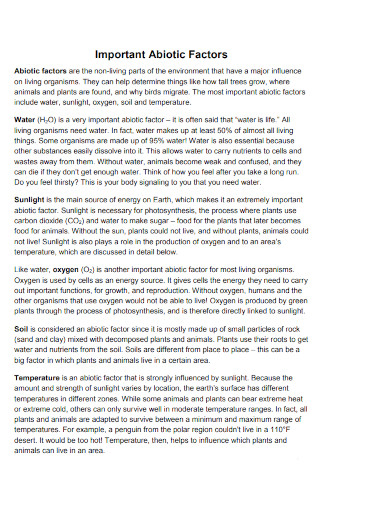
cusd80.com
Details
File Format
Size: 100 KB
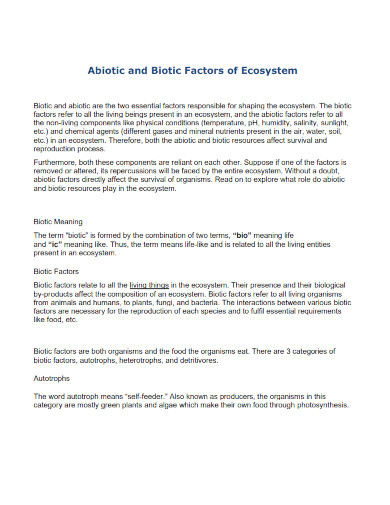
maharajacollege.ac.in
Details
File Format
Size: 61 KB
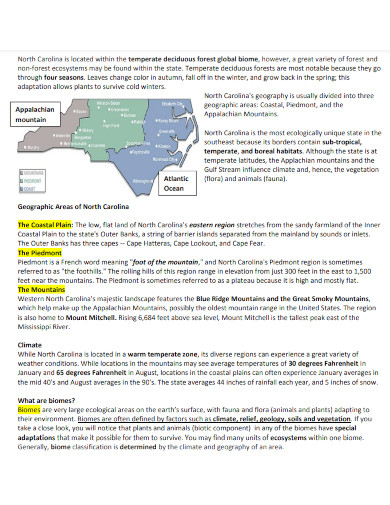
wsfcs.k12.nc.us
Details
File Format
Size: 97 KB
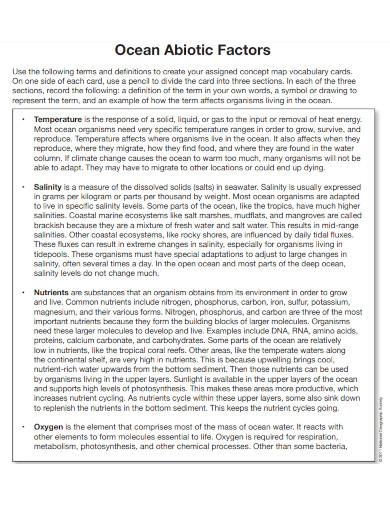
media.nationalgeographic.org
Details
File Format
Size: 115 KB
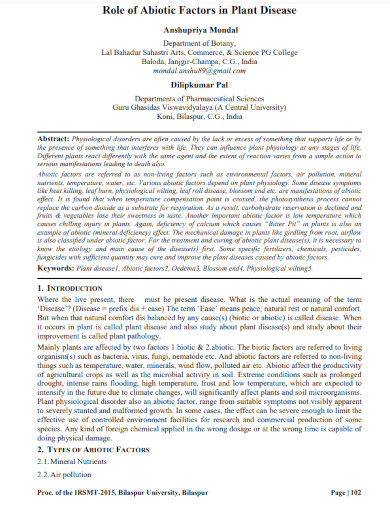
arcjournals.org
Details
File Format
Size: 98 KB
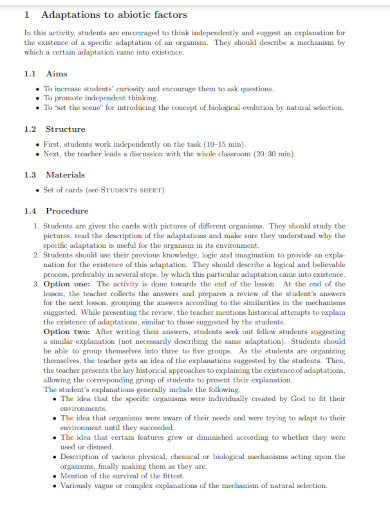
ist.ac.at
Details
File Format
Size: 81 KB
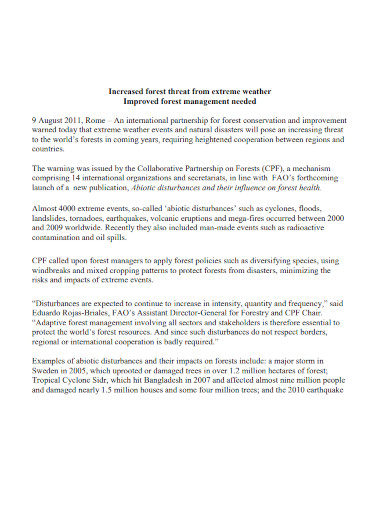
cbd.int
Details
File Format
Size: 65 KB
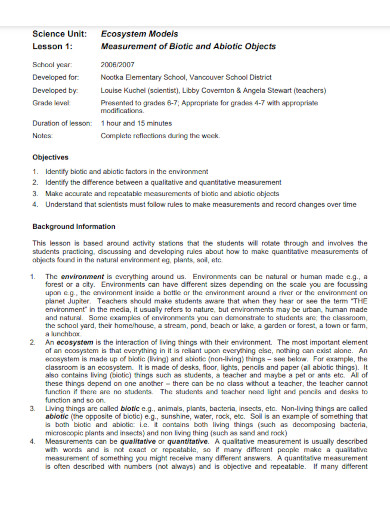
scientistinresidence.ca
Details
File Format
Size: 98 KB
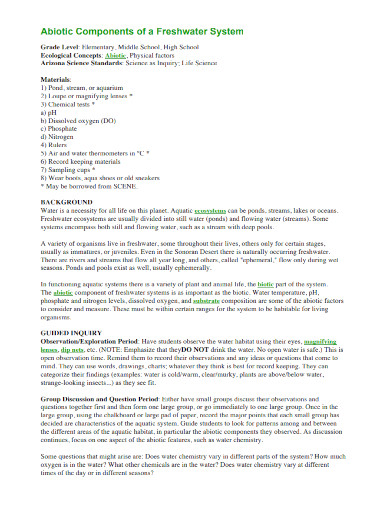
d3dqsm2futmewz.cloudfront.net
Details
File Format
Size: 76 KB
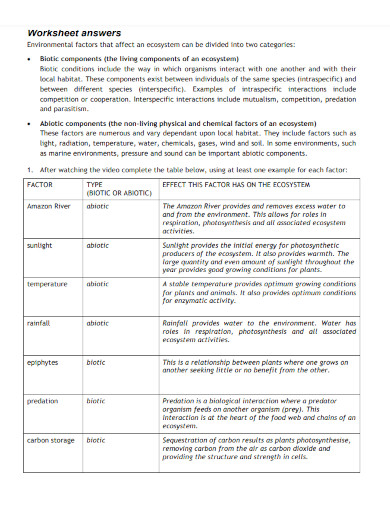
uwa.edu.au
Details
File Format
Size: 82 KB
Abiotic or abiotic factors refer to inorganic and nonliving characteristics that make up the inorganic structure of a specific ecosystem. These factors can affect the quality of life and survival instincts of all the organisms that live within the specific ecosystem.
Abiotic factors can determine the number of biotic factors and adaptations held by the said biotic factors in the ecosystem. Conservation of the ecosystem is very important, but one needs to understand the basic connection between abiotic and biotic factors in a specified ecosystem.
Begin by creating a list or table of various abiotic categories for yourself to fill. This should include base temperature, climate, general weather conditions, water, amount of water formations, land masses, presence of topsoil, quality of the soil, air, and acidity of the soil.
Start by researching the temperature and base weather conditions of the chosen ecosystem. Not only that but determine if the climate is dry, arid, or humid. These abiotic factors will affect the way the flora and trees will propagate in the landscape.
After you have done that, you must look up the various water formations and land masses that fill the ecosystem. You will also need to determine whether there is the presence or absence of topsoil and how the wind interacts with the land masses. These abiotic factors will determine the adaptations of the flora and fauna of the chosen ecosystem.
If there is the presence of soil in the ecosystem, determine the quality and acidity present in the soil. The quality of the soil is usually determined by the presence of decomposers and organic matter on the topsoil.
Abiotic factors are the non-living components of a specific ecosystem and biome, which includes land formation, soil availability, water, sunlight, and wind. Abiotic factors affect various organisms in the food chain or web. For example, decomposers are more effective in locations that have more soil and sunlight, like the abiotic factors of tropical rainforests; but are less effective in locations with less presence of soil, like a desert’s abiotic factor. Abiotic factors have a lot of say in the various adaptations, coevolution, and mutations of all the organisms in the ecosystem which can affect various placements of fauna and flora in the food chain or food web. Therefore, abiotic factors can greatly affect all the organisms in the food chain or food web.
Each ecosystem has a group of factors that make up all the living and nonliving objects and characteristics present in the given biome or environment. The abiotic factor presents itself as all the collected nonliving and non-organic factors in a given biome or ecosystem. For example, water availability and soil quality are abiotic factors of a given biome. Biotic factors are the complete juxtaposition of abiotic factors, as they present all the living organisms (see bio) of a given ecosystem or biome, which are split into three different categories of consumers, producers, and decomposers. In conclusion, abiotic factors refer to all the inorganic things in a given biome, while biotic factors refer to all living organisms in the given biome.
The ocean is a large ecosystem that spans a large area in the whole biosphere. This ecosystem hosts a large amount of salt water that will heavily affect the organisms living in the exosystem. Not only is the ocean primarily saltwater, but the land formations are also submerged deep under large quantities of water. This fact makes swimming the primary factor or mode of transportation in the ecosystem. The depth of the ocean will also affect the presence of sunlight in the water. All of these are examples of abiotic factors one can observe in the ocean.
Abiotic factors are all the inorganic objects and characteristics a certain ecosystem or place has, which contribute to the adaptation and growth of all the biotic factors in the given habitat. Knowing the abiotic factors of a given ecosystem will allow the person to know the effects each factor has on the survival of all the living organisms in a given ecosystem. Therefore it is important to know and understand the concept of abiotic factors.
Text prompt
Add Tone
10 Examples of Public speaking
20 Examples of Gas lighting
Which of the following is considered an abiotic factor in an ecosystem?
Plant growth
Soil pH
Animal behavior
Predator-prey relationships
How do abiotic factors like temperature impact an ecosystem?
By influencing the rate of photosynthesis
By affecting the availability of food sources
By determining the types of plants and animals that can survive
By altering the behavior of animals
Which of the following is an example of an abiotic factor affecting aquatic ecosystems?
Fish migration patterns
Water temperature
Algae growth
Predation by fish
Which abiotic factor would most likely affect the rate of erosion in a river?
Vegetation cov
River current velocity
Fish population
Bird migration patterns
How does sunlight function as an abiotic factor in ecosystems?
By providing nutrients to soil
By affecting the growth of plants
By influencing animal migration
By regulating predator-prey interactions
What role does soil composition play in an ecosystem?
It affects the types of organisms that can thrive in the area
It determines the social structure of animal communities
It influences the migration patterns of birds
It controls the breeding behavior of fish
Which abiotic factor is most likely to influence the distribution of desert plants?
Soil fertility
Water availability
Animal interactions
Plant competition
How does wind as an abiotic factor affect plant life?
By increasing soil erosion
By promoting plant competition
By affecting nutrient availability
By influencing plant reproduction and dispersal
Which of the following abiotic factors affects the rate of decomposition in an ecosystem?
Animal foraging habits
Soil moisture levels
Plant diversity
Predator populations
Which abiotic factor would most impact the biodiversity of a coral reef?
Water salinity
Coral competition
Fish predation
Algae growth
Before you leave, take our quick quiz to enhance your learning!

